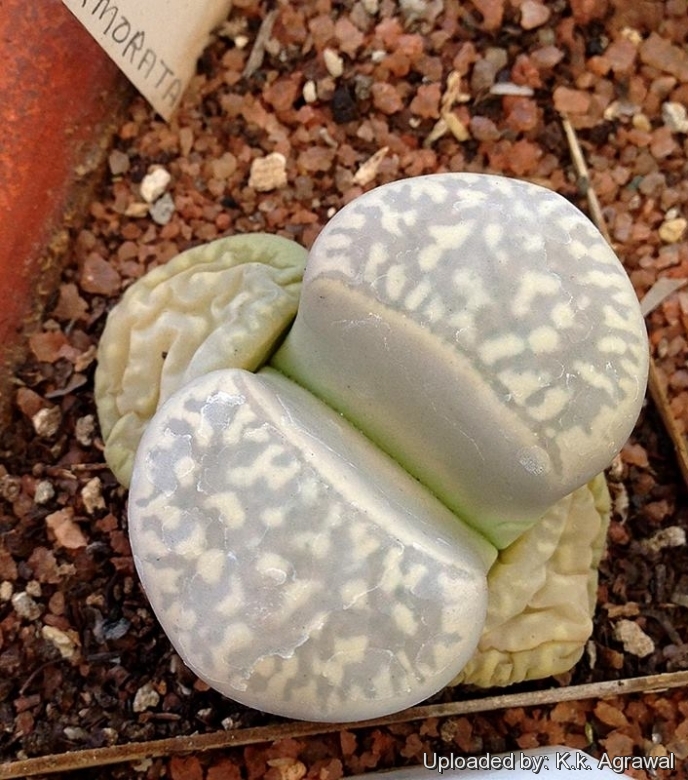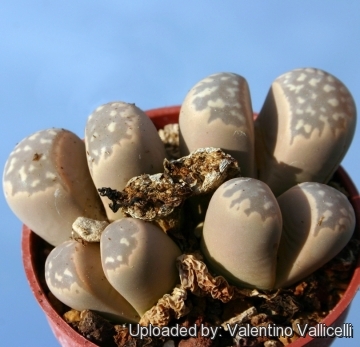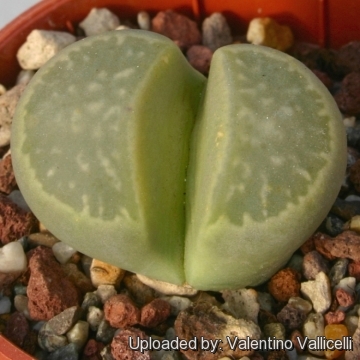Accepted Scientific Name: Lithops marmorata (N.E.Br.) N.E.Br.
Gard. Chron. 1922, Ser. III. lxxi. 80

Mesembryanthemum marmoratum (Lithops marmorata) Photo by: K.k. Agrawal
Origin and Habitat: South Africa (Cape Province, Little Namaqualand) in a square area between Steinkopf, Port Nolloth, Pofadder, and Vioolsdrif.
Habitat: Lithops marmorataSN|13107]]SN|13107]] grows grows sunken in rocky environments and has white to pale grey leaves and closely mimics the white quartzite pebbles on which they grow and are lost to sight in this environment. When they are found, it is usually due to their large and brightly coloured flowers. Stone: Quartzite; gneiss; pegmatite and gneiss; pegmatite and calcrete; pegmatite and schist. Colours grey-white, light brown, pink, brown, red-brown, some greyish green. It grows in areas which receive either more rain or expect a different rainy season. The higher the rainfall and the further the season lies in summer.
Synonyms:
See all synonyms of Lithops marmorata
back
Accepted name in llifle Database:Lithops marmorata (N.E.Br.) N.E.Br.Gard. Chron. 1922, Ser. III. lxxi. 80Synonymy: 12
Accepted name in llifle Database:Lithops marmorata var. elisae (de Boer) D.T.ColeExcelsa 3: 48 (1973)Synonymy: 5
Cultivars
(1):
back
Common Names include:
ENGLISH: Stone Plant, Split Rocks, Living Rocks, Cleft Stones, Living Stones
ITALIAN (Italiano): Pianta Sasso
Description: Lithops marmorataSN|13107]]SN|13107]] is a tiny perennials succulent plant close related to Lithops salicolaSN|13111]]SN|13080]] and Lithops umdausensisSN|13080]]SN|13111]]. The colour is grey-white or pale grey-green sometimes with a purplish flush. The upper surfaces of leaves is convex and quite variable in appearance, it has darker translucent windows mottled with white with an overall marbled effect. Bears a white flower in late summer or early autumn.
Habit: Lithops marmorataSN|13107]]SN|13107]] consists of a pair of almost stemless succulent leaves that grows solitary or forming clumps of 2 or more heads (occasionally up to 26).
Bodies (paired leaves): Small to medium sized, inverse-cone-shaped, truncate-cordate, 20-36 mm long, 15-23 mm broad, 20-30 mm tall. Lobes unequal-sized, swollen, separated by a deep fissure to 10 mm deep, usually somewhat divergent. The new leaves are opposed with respect to the previous ones and form a right angle with these. Top of lobe ovoidal and more or less elonged, flush to slightly convex, smooth to slightly rugose. Sides coloured light green-yellow, with upper edge slightly purple. Window large grey-green, mottled with palegrey or creamy-green. Outer margin usually distinct, very irregular, consisting of a number of jagged fine projections into the window, others being short toothlike: these projections become separated from the margin and form islands (irregular) in the window; inner margins straight or toothed. The texture of the mottled part of the lobe is very fine, giving the whole window a fine misty appearance like fine cobweb, number of fine white dots in the window.
Flowers: Single glossy white daisy-like that emerges from the fissure, the flower is as large as the pair of fleshy leaves below (2,5-4,5 cm in diameter).
Blooming season: From mid-summer through autumn.
Fruits: Capsules usually 6-parted, Profile boat-shaped, with broad flattened pedicel, top flat. Face broadly elliptic to almost round.
Seeds: Light yellow-brown to yellow-brown; rugose -tuberculate.
Subspecies, varieties, forms and cultivars of plants belonging to the Lithops marmorata group
 Lithops framesii L. Bolus: L. framesii and L. marmorata are probably exactly the same and they comes from the same area even from the same colonies. Distribution: Little Namaqualand.
Lithops framesii L. Bolus: L. framesii and L. marmorata are probably exactly the same and they comes from the same area even from the same colonies. Distribution: Little Namaqualand. Lithops marmorata (N.E.Br.) N.E.Br.: It is solitary or forming clumps of 2 or more heads. It is normally a grey bodied plant with sides coloured light grey-green-yellow, the top of lobes is slightly convex, smooth with fairly open grey-green coloured window, usually marbled in appearance and sometimes with a purplish flush. The flowers are white.
Lithops marmorata (N.E.Br.) N.E.Br.: It is solitary or forming clumps of 2 or more heads. It is normally a grey bodied plant with sides coloured light grey-green-yellow, the top of lobes is slightly convex, smooth with fairly open grey-green coloured window, usually marbled in appearance and sometimes with a purplish flush. The flowers are white. Lithops marmorata C058 (syn. framesii) 45 km ENE of Springbok, South Africa
Lithops marmorata C058 (syn. framesii) 45 km ENE of Springbok, South Africa- Lithops marmorata C163 25 km NE of Steinkopf, South Africa: large transparent mottled window.
 Lithops marmorata C260 (syn. diutina) 15 km ENE of Steinkopf, South Africa: pale whitish grey.
Lithops marmorata C260 (syn. diutina) 15 km ENE of Steinkopf, South Africa: pale whitish grey. Lithops marmorata C305 40 km NNE of Steinkopf, South Africa: pinkish beauty.
Lithops marmorata C305 40 km NNE of Steinkopf, South Africa: pinkish beauty. Lithops marmorata C360 35 km NE of Steinkopf, South Africa
Lithops marmorata C360 35 km NE of Steinkopf, South Africa Lithops marmorata C365 (syn. framesii) 60 km NE of Springbok, South Africa
Lithops marmorata C365 (syn. framesii) 60 km NE of Springbok, South Africa- Lithops marmorata var. elisae (de Boer) D.T.Cole: It has grey leaves with dark lines across the leaf faces, and white flowers. It occurs throughout the western reaches of Bushmanland.
 Lithops marmorata var. elisae C214 35 km SE of Vioolsdrif, South Africa: grey body, jagged window.
Lithops marmorata var. elisae C214 35 km SE of Vioolsdrif, South Africa: grey body, jagged window. Lithops marmorata var. elisae C251 TL: 30 km SE of Vioolsdrif, South Africa: coarse ivory spots.
Lithops marmorata var. elisae C251 TL: 30 km SE of Vioolsdrif, South Africa: coarse ivory spots. Lithops marmorata var. elisae C252 30 km SSE of Vioolsdrif, South Africa: milky grey, dark lines.
Lithops marmorata var. elisae C252 30 km SSE of Vioolsdrif, South Africa: milky grey, dark lines.- Lithops marmorata cv. Polepský Smaragd: Emerald glass cultivar. Origin: Czech Republic.
Bibliography: Major refences and further lectures
1) Heidrun E. K. Hartmann “Aizoaceae F – Z” Springer 2002
2) Achim Hecktheuer “Mesembs, mehr als nur Lithops” Books on Demand GmbH Norderstedt. 2008
3) Desmond T. Cole & Naureen A. Cole, Uwe Beyer, Yves Delange “Les Lithops” SUCCULENTES Spécial 2008 AIAPS (now Terra seca). 2008
4) Desmond T. Cole & Naureen A. Cole “LITHOPS Flowering Stones” Cactus & Co. Libri. 2005
5) Yasuhiko Shimada “The Genus Lithops” Dobun Shoin. 2001
6) Rudolf Heine “Lithops - Lebende Steine” Neumann Verlag. 1986
7) Bernd Schlösser “Lithops – Lebende Steine” Praktische Anleitung für die Zimmerkultur. BussinessPoint MEDIA. 2000
8) Steven A. Hammer “Lithops – Treasures of the veld” British Cactus and Succulent Society. 1999
9) Desmond T. Cole “Lithops – Flowering Stones” Acorn Books 1988
10) Rudolf Heine “Lithops – lebende Steine” Neumann Verlag. 1986
11) David L. Sprechman “Lithops” Associated University Presses, Inc. 1970
12) Gert Cornelius Nel “Lithops” Hortors Limited, South Africa 1946
13) Edgar Lamb "The illustrated reference on cacti and other succulents" Blandford Press. 1978
14) Christopher Brickell, Royal Horticultural Society "RHS A-Z Encyclopedia of Garden Plants: K-Z., Volume 2" Kindersley, 2008
15) G. C . Nel “Lithops: Plantae succulantae, rarissimae, in terra obscuratae, e famailia Aizoaceae, ex Africa australi” Hortors Limited, Cape Town, South Africa 1946
16) Heidrun E. K. Hartmann "Illustrated Handbook of Succulent Plants: Aizoaceae F-Z" Springer, 2002
17) Steven A. Hammer "Lithops: Joyaux du veld" Editions Quae, 25/nov/2010
 Seedlings. (Lithops marmorata) Photo by: Giuseppe Distefano
Seedlings. (Lithops marmorata) Photo by: Giuseppe Distefano Mesembryanthemum marmoratum (Lithops marmorata) Photo by: Valentino Vallicelli
Mesembryanthemum marmoratum (Lithops marmorata) Photo by: Valentino Vallicelli Mesembryanthemum marmoratum (Lithops marmorata) Photo by: Valentino Vallicelli
Mesembryanthemum marmoratum (Lithops marmorata) Photo by: Valentino VallicelliSend a photo of this plant.The gallery now contains thousands of pictures, however it is possible to do even more. We are, of course, seeking photos of species not yet shown in the gallery but not only that, we are also looking for better pictures than those already present.
Read More... Cultivation and Propagation: The Lithops (a.k.a. Living Stones) are some of the world's most fascinating plants and are sought by the collector of succulent plants. Paying attention to the particular growing requirement of Lithops is especially important. If you provide the Lithops with the right conditions, they will reward you with their unique shape, size, colour and a proliferation of blooms in autumn. However, Lithops are tricky plants that are very particular about their growing conditions and require the right maintenance in order to keep happy. But don't be afraid even the best growers have plants that mysteriously dry up, or leave during the night. While Lithops are picky about their care, if you are patient and remember the basics, your efforts will be rewarded. Being small plants, a representative collection can be grown on a patio table, a sunny windowsill or a shelf in the greenhouse.
Growing rate: Slow growing for a mesemb.
Soil: They grow best in an open mineral, sandy-gritty soil and requires good drainage as they are prone to root rot. They can grow outdoor in sunny, dry, rock crevices (protection against winter wet is required) They can also be cultivated in alpine house, in poor, drained soil.
Repotting: They may stay in the same pot for many years. Plants grown in larger containers have frequently relatively poor flowers. Flowers might improve when the plants are given their own, small individual pots.
Watering They Require little water otherwise the epidermis breaks (resulting in unsightly scars). The basic cultivation routine is: Stop watering after flowering. Start watering after the old leaves are completely dry (usually late March or Early April). Water freely during the growing season, soak the compost fully but allow it to dry out between waterings. In the winter season the plant doesn’t need watering, the plant in this time extracts water from the outer succulent leaves, allowing them to shrivel away, relocating water to the rest of the plant and to the new leaves that form during this period. If grown in a container, bottom watering by immersing the container is recommended. Water sparingly only when warm, no water when cold. Nearly all problems occur as a result of overwatering and poor ventilation, especially when weather conditions are dull and cool or very humid. They must have very dry atmosphere.
Fertilization: Feed them once during the growing season with a fertilizer specifically formulated for cactus and succulents (high potash fertilizer with a dilute low nitrogen), including all micro nutrients and trace elements diluted to ½ the strength recommended on the label. They thrive in poor soils and need a limited supplies of fertilizer to avoid the plants developing excess vegetation, which is easily attacked by fungal diseases. Some growers fertilize frequently, some hardly ever. However, for the highly succulent mesembs, (Lithops, Conophytums, etc.) fertilization is not really necessary.
Light: They prefer a very bright situation and in winter they need the maximum amount of light you are able to give them, but keep more cool and partially shaded in summer. The only exception to this is seedlings in their first year that enjoy a shades place. Such tiny plants can easily get scorched or broiled and their appearance spoiled (this may not matter in the wild, where the Lithops have probably shrunk into the ground and becomes covered with sands). Outdoor (Lithops prefer full sun, with some shade in the hottest summer months. High levels of light are needed in autumn to flower and for good plant development. The low intensity of sun light during the growing season of this species generally prevents the white flower flowers from opening.
Special Advice: Lithops are best planted in a sunny and airy part of the greenhouse, and not too close to the glass roof or sides of the house as the plants can overheat during hot spells.
Hardiness: They require a minimum temperature 5°C (But will take a light frost and are hardy down to -7° C for short periods if they are in dry soil). USDA zones 9A – 11.
Uses: Container, rock garden.
Pests & diseases: Lithops may be attractive to a variety of insects, but plants in good condition should be nearly pest-free, particularly if they are grown in a mineral potting-mix, with good exposure and ventilation. Nonetheless, there are several pests to watch for:
- Red spiders: they may be effectively rubbed up by misting the vulnerable plants every day.
- Mealy bugs: occasianlly they develop aerial into the new leaves and flowers with disfiguring results, but the worst types develop underground on the roots and are invisible except by their effects.
- Sciara Flies: they are one of the major problems for seedlings. It is a good practice to mulch your seedlings with a layer of grit, which will strongly discourage the flies.
- Scales, thrips and aphids: (they are rarely a problem.)
It is wise to treat your whole collection with a systemic insecticide twice a year in spring and autumn.
- Rot: it is only a minor problem with mesembs if the plants are watered and “aired” correctly. If they are not, fungicides won't help all that much.
Remarks: After flowering in the autumn and extending through winter season the plant doesn’t need watering, but they will still be growing, the new bodies will be increasing in size extracting water from the outer succulent leaves, allowing them to shrivel away. In fact the plant in this time extracts water and nutrient stored in the outer succulent leaves, allowing them to dehydrate relocating the water to the rest of the plant and to the new leaves that form during this period until the old leaves are reduced to nothing more than "thin papery shells".
Propagation: Seed or (or rarely) cuttings. The small seeds can be sown in pots of fine, well-drained sand, any time during the spring and summer months when temperatures are warm. Cover the seeds with a very fine layer of grit and water from below with a fungicide to prevent damping off. For the first 3-4 days cover the pots with a sheet of glass/clear perspex to keep the humidity levels high. Remove the glass and replace it with light shadecloth and mist once or twice a day for the next two weeks after which most seeds should have germinated. From then on mistings can be reduced to every second and then every third day as the little plants grow. Take the cuttings from a grown-up mother plant. Each cutting must contain one or more heads along with a fraction of root and permit them to dry out a couple of days, lay the cuttings on the soil and insert the stem end partially into the soil. Try to keep the cutting somewhat upright so that the roots are able to grow downward. It is relatively difficult to root Lithops from cuttings and generally pointless as well, so quick are they from seed.
Comment: Improvement of Lithops characteristics: Some growers (but not all!!) think it is very intriguing to reinforce any characteristic of cultivated Lithops of by crossing two similar selected plants and then back-crossing with the mother plant. This way we can eventually get some interesting results. Of course, many of the nicest Lithops we grow in cultivation have already been selected over time. However many Lithops are already nice plants which can’t really be improved, on the other hand one could try to improve the colour or the markings etc. Now if we have two particular plants we may attempt to breed between them and can maybe get a whole improved population and then select some better offspring to continue the selection.
Seed production: Plants can be hand pollinated, using a small paint brush. Remember always to cross different clones as the plants are self-sterile. The seed will remain viable for many years provided it is stored in a cool dry place.













